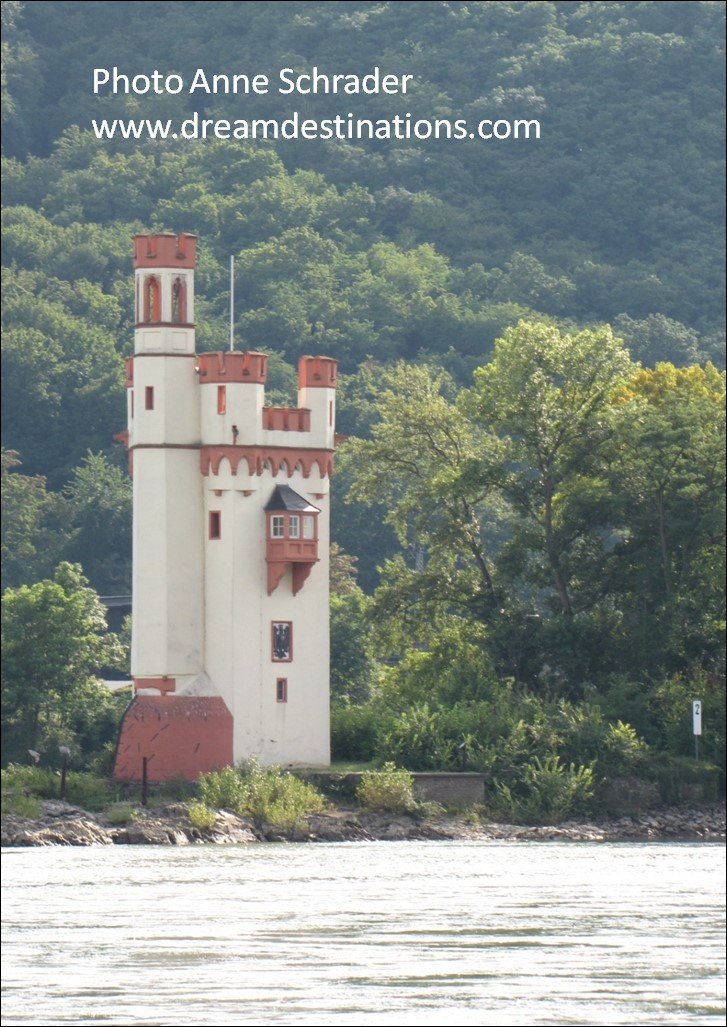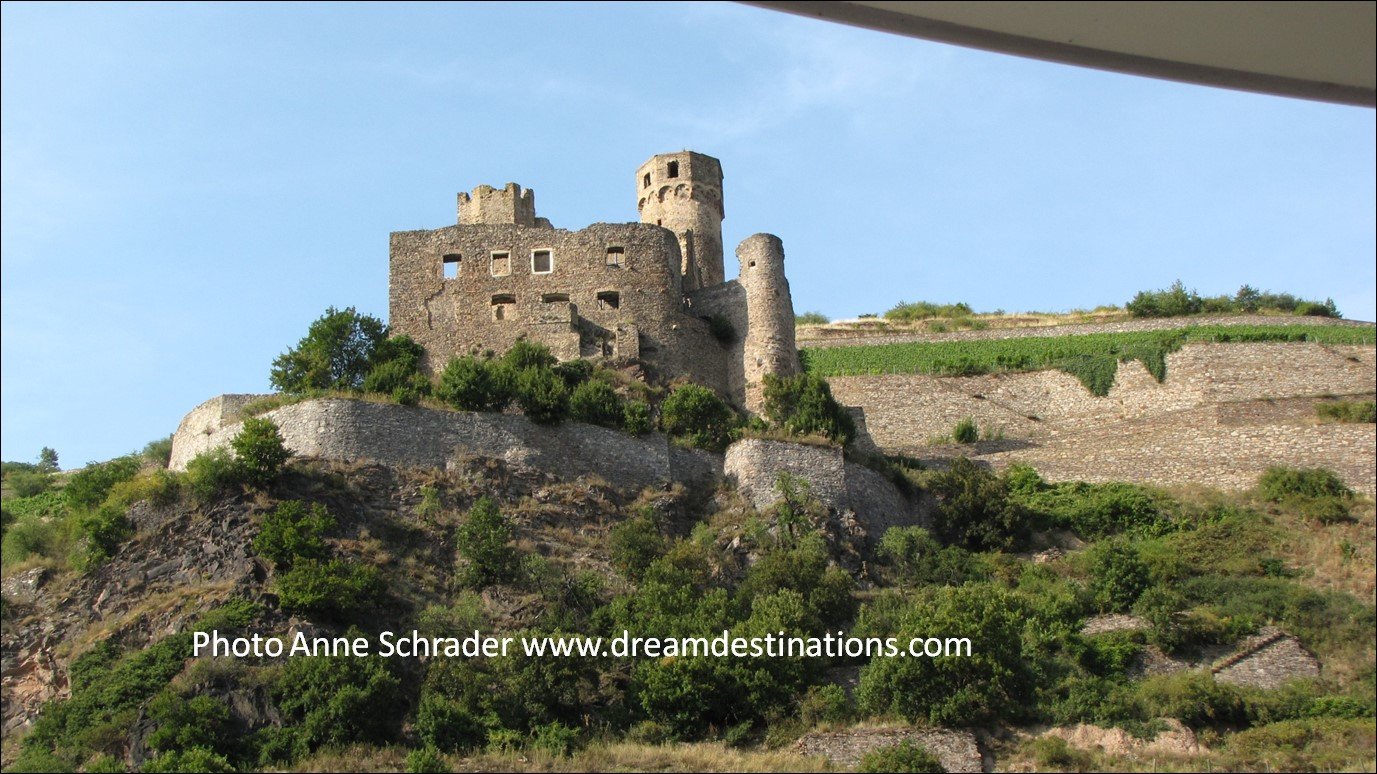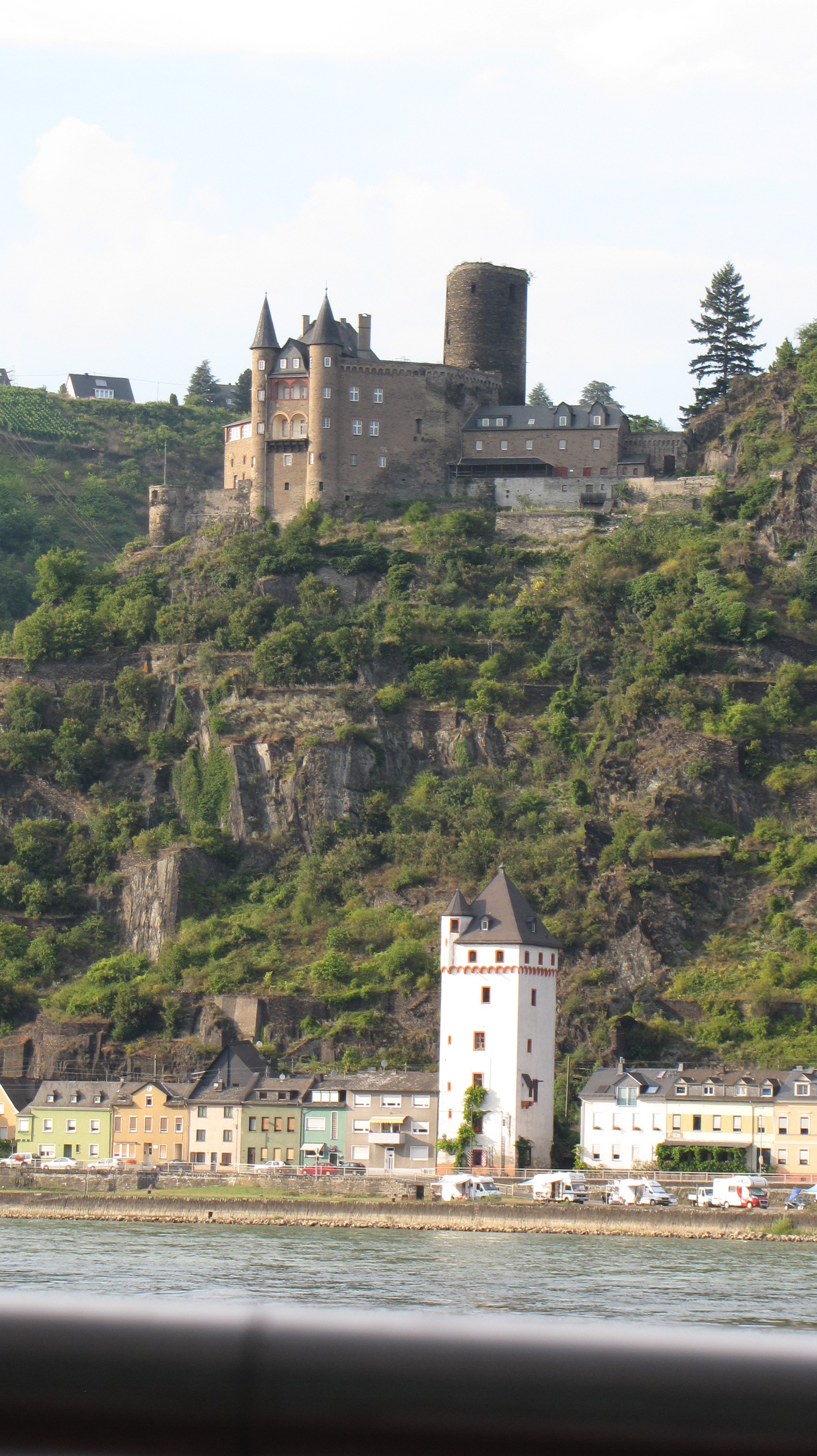Castles on the Rhine Gorge
Hank Schrader, USMA '71, Europe Destination & Europe River Cruise Expert
Anne Schrader, Certified Travel Counselor & Certified Luxury Cruise Specialist
In 1971, during my first visit to Europe. I took a KD cruise through the Middle Rhine River castles between Mainz to Koblenz. The are 40 castles, some in ruins, and some you can actually visit.
Overview
The Rhine River Gorge has the greatest concentration of scenic banks and castles in all Europe. It never gets old! This 65 km stretch of the Rhine has always been an important transportation route. The 40 castles that dot the steep hillsides were erected over a period of around 1,000 years ago to protect land holdings and exact tolls. Most are now picturesque ruins, as they were either destroyed in wars or abandoned. Still, you can feel like you are part of a bygone time cruising this portion of the river. No wonder, it is an UNESCO World Heritage Site.
A Few Facts About Medieval Castles of the Rhine
These military structures were built for one reason—to defend the owner’s property and everything else is secondary. This concentration of these castle were in the heart of the old Holy Roman Empire where the Rhine was one of the most important, if not the most important transportation routes of the Empire.
These castle were prepared as a defense in depth—there were always a series of obstacles and defensive positions to provide the defenders with advantages during a siege or attack.
Castles became obsolete with the invention of more modern weapons and especially gunpowder .
Klopp Castle Bingen
Klopp Castle is the most famous landmark in Bingen but most folks on the river are drawn to the Mausetuen, as it is more colorful than the stark walls of Klop Castle.
Klopp Castle
Mauseturm Bingen
The Mouse Tower is one of the best legends of the Rhine Castles in this area. The wicked archbishop of Mainz Hato hoarded grain from the townsfolks. One day, for his harsh ways, he was attacked by mice and rats who gnawed him to death. The tower is on an island of the Rhine near Bingen and is used today as a lighthouse.
Mauseturn
Ehrefels Castle
It was built in 1211 and remodeled in 1365. It is in ruins today. It once safeguarded the cathedral treasures in times of rebellion and unrest. It finally was destroyed by the French in 1689.
Ehrefels Castle
Ehrefels Castle
Rheinstein Castle
First built around 1000, perched 279 feet above the Rhine River, it always was a castle designed to collect tolls. Later, it became the felon’s court of Mainz in 1200. From 1282 to 1286, Rudolph von Hapsburg, the Holy Roman Emperor resided in this castle. By 1632 it was a ruin.
It has since been restored and is open to the public. Inside are stained glass windows and mural paintings as well as a Renaissance fireplace and stylish furniture. Castle and medieval games take place in the Knight’s Hall. The castle can only be reached by a short footpath.
Rheinstein Castle
Rheinstein Castle
Reichenstein Castle
The legend of this castle is one of a ghost king. The robber knights of this castle were in conflict with the Holy Roman Emperor Rudolph who lived in Rheinstein Castle. Rudolph finally captured the castle and condemned the Noble rulers and his 10 sons. The father begged Emperor Rudolph to spare his sons. Rudolph agreed if father of the clan could walk past all his sons after his head had been cut off.
According to the legend, his will was so strong he walked past them and the dropped dead to the ground.
Burg Reichenstein is well preserved, has a good collection of armor on display.
The castle has a small hotel and restaurant available for guests.
Burg Reichenstein
Burg Reichenstein
Burg Reichenstein
Soonech Castle
This castle is built on the outermost tip of the Soon Forest. It was built around 1271 but not many years later, in 1282, besieged by Rudolph and destroyed.
It was later rebuilt but later destroyed by the French during the during the War of the Palatine Succession.
Soonech Castle
Soonech Castle
Heimberg Castle
Heimberg Castle was built to counter the castles of Soonech and Reichenstein by Count Ludwig the Severe (you can’t make these names up—amazing even for ages past!). It is now a private residence.
Heimberg Castle
Heimberg Castle
Nolling Castle
Nolling Castle was originally known as the watchtower—it really is not a true castle but part of the northwest Lorch city walls. It is near the town of Lorch. The castle was built to counter the power of Burg Furstenberg on the opposite bank of the Rhine.
Nolling Castle
Nolling Castle
Nolling Castle
Fürstenberg Castle
Now in ruins, this castle was bult in 1219 by the archbishop of Cologne. In 1620, the castle was taked by Spanish forces and in 1632 the Sweedish forces captured it. The French fina;;y finished off this castle during the Palatine war of succession (1688-1690) and has been in ruins ever since.
Fürstenberg Castle
Fürstenberg Castle
Stahleck Castle
This fortified castle was built on a crag 520 feet above the river. Like most castles on this section of the Rhine, it was destroyed during the 30 Years War and later by the French around 1689. Now it is a youth hostel with more than 42,000 bookings a year.
Stahleck Castle
Stahleck Castle
Stahleck Castle
Pfalzgrafenstein Castle Toll Station
Perhaps the most dramatic castle/toll station of this whole area, this fortified position is in the middle of the Rhine at a very shallow point of the river. It was the perfect place to exact tolls, as it was almost impossible to avoid merchants and ships sailing on the Rhine.
Pfalzgrafenstein Castle Toll Station
Pfalzgrafenstein Castle Toll Station
Pfalzgrafenstein Castle Toll Station
Pfalzgrafenstein Castle Toll Station and Gutenfels Castle on the hill
Gutenfels Castle
Gutenfels Castle is high on the hill (110 meters) overlooking Kaub. The castle worked with Pfalzgrafenstein toll station.
Gutenfels Castle
Gutenfels Castle
Schonburg Castle
This castle was built starting in 1116. It is above the medieval town of Oberwesel. This was another castle to collect tolls until 1689 when the French burned it down.
This castle sometimes been described as “the most beautiful refuge on the Rhine during the Romantic Era”.
It is now a hotel and restaurant.
Schonburg
Schonburg
Schonburg Castle
Schonburg
Lorelei (Loreley)
This rock formation is at the narrowest part of the Rhine River. The resulting swift current brought about a legend of a female water spirit than caused sailors to get distracted and wreck their boats.
Loreley
Loreley
Loreley Statue
Katz Castle
Katz Castle was built in 1371 to collect tolls on the Rhine River. The official name of the castle that overlooks the village town of St. Goarshausen is “Neukatzenellbogen”.
The castle was built by the Counts of Katzenelnbogen, so it is easy to see how the name was shortened by locals to Burg Katz.
In 1626, the castle was besieged by the Electorate of Cologne and while courageously defended by 10 cannons and 80 soldiers, surrendered after 5 weeks when they ran out of ammunition. The 7 electors of the Holy Roman Empire were constantly trying to increase their power and ranking among the 7 Electors, so armed conflict was just one means of getting more power.
France always feared a strong Germany, and they invaded this region in an effort to assert its superiority and dominance of the small, un-unified German kingdoms. Both Germany and France wanted control of the Rhine River. This important transportation river soon became an area of international conflict.
The next siege came in 1692 by the French. The castle survived other attacks until in 1806 it was ordered blown up by Napoleon.
By 1770 it was in total decay. It has been restored and now is used for a holiday center for German financial authorities. Burg Katz is closed to the public.
Katz Castle
Katz Castle
Katz Castle
Rheinfels Fortress
Built in 1245, this castle was constantly improved and fortified. It is the largest castle on the Rhine and could shelter 4,000 people and stand a 6-month siege—it successfully defied 28,000 French soldiers for 6 month. In 1792, the commander of Rheinfels handed over the fortress to the French, who destroyed it, Visitors can tour the ruins.
Rheinfels Fortress
Rheinfels Fortress
Rheinfels Fortress
Rheinfels Fortress
Maus Castle
Burg Maus (officially Thurnberg Castle) is much smaller than Burg Katz but is higher on the hillside and looks like to me, taunting the larger Katz Castle to come and get me.
It overlooks the Wellmick village and construction began on this castle around 1356. The castle has a massive shield wall, and the keep (highest tower) is part of this wall. Directly opposite this smaller castle is Rheinfels Castle.
Burg Maus was built to secure the borders of Trier against the Counts of Katzenelenbogen’s territory and to collect tolls. Burg Maus was never destroyed.
Today it is used as a falcon training center and is open for visits.
Maus Castle
Maus Castle
The Katz and Maus Feud
The two Rhine River castles, Burg Katz and the smaller Burg Maus got their name from two feuding lords in the late 1300’s. Their different size and proximity to each other makes them a special part of the lore of the over 40 castles in the Rhine River Gorge.
To understand the rivalry of these two castles, many of these castles were constructed on this stretch of the Rhine by competing factions trying to gain more wealth and power Burg Katz, across the river from Rheinfels castle, was built by to support Rheinfels fortress, while Burg Maus was built by the Electorate of Trier (one of the 7 voters for the selection of the Holy Roman Emperor) near Katz castle to undermine its’ power by also collecting tolls from the river merchants.
The Waring Brothers
This is another great legend of the Rhine Castles. This is the story of 2 great castles, two brothers who pursued the lovely Angela to marry.
The castle with the big white tower, Burg Sterrenberg, and Burg Liebenstein were once very friendly. This changed when the 2 brothers, Henry and Konrad, both wanted to marry Angela and she must now decide.
Konrad was a knight and went away to war. Angela decided to wait for him. She was devastated when he returned with a wife from Greece after 5 years. When Konrad sailed done the Rhine , he saw a black flag on top of Burg Sternenberg and realized his father was dead and a new castle, Berg Liebenstein built.
Konrad landed, and drew his sword as a sign of respect to salute his father. Henry mistakenly thought Konrad was attacking him and drew his sword, as the anger boiled over. Angela got between the waring brothers and almost was killed.
Both brothers retreated to their castles, K onrad built a wall and the devastating Angela became a nun.
The whole result was a huge wall between the castles, a grieving girl and a family ripped apart.
The Waring Brothers—Burg Sterrenberg on the Left: Burg Liebenstein on the right
The Waring Brothers Burg Sterrenberg (left) and Burg Liebenstein (right)
Burg Sterrenberg (lower Castle); the Wall and Burg Liebenstein
Burg Liebenstein
Burg Sterrenberg
Marksburg Castle
Marksburg is the only castle that was never sacked or ruined among the 40 some odd castles along the Rhine Gorge stretch from Koblenz to Rüdesheim. It is above the town of Braubach. Marksburg was built and served as primarily a fort and often these countryside castles lacked the grandeur of royal palaces. The white pained castle with red trim is distinctive and has a butter-churn keep tower, as the lower parts of the tower are wider than the upper parts and it resembles a butter-churn devise.
Marksburg Castle
Marksburg Castle
The construction of Marksburg was intended to defend the town and after entering the castle the first area in the Great Battery with its firing positions designed to protect the Rhine and town from enemies.
Marksburg Castle
The next area on the tour is the wine cellar.
The gothic Hall was the kitchen area of the castle fort.
The next area was the sleeping area.
Next is the Chapel
Now the Armory Museum, called the Gimbel collection, uses life-sized figurines to show the changes in armor and weaponry through the ages.
Finally, the Horse Stables, which also was used as a prison complete with torture devices.
Stozenfels Castle
Stozenfels Castle the castle is located approx. 5 km to the south of Koblenz, which was originally built as a customs fortress and was destroyed by the French in 1689 in the Palatine War of Succession. It was rebuilt according to the plans of the Berlin master builder Schinkel and is now open to the public. It houses a number of valuable furniture pieces and a collection of armor and weapons. Here are some pictures:
Stozenfels Castle
Stozenfels Castle
Stozenfels Castle
Martinsburg Palace
This castle was built as a toll station for the archbishop of Mainz.
Martinsburg Palace
Lahneck Castle
This is a great castle to tour, as combines medieval fortifications, and great interiors. It was built in 1244 and destroyed in the Thirty Years War (1633). In 1852, it was rebuilt and finally fully restored in 1937.
Lahneck Castle
Lahneck Castle view from the Rhine River
It is a very interesting and pretty residential castle. The stained-glass windows of the chapel date to the 1400s. There is even a portrait of Queen Victoria, painted in 1840.
Chapel Lahneck Castle
Queen Elizabeth Painting
It is full of fine furniture, porcelain, ceramics, a 15th century kitchen complex and a fully furnished 3-story doll house.
Porcelain Heater Lahneck Castle
Doll House Lahneck Castle
Ehrenbreitstein Fortress
Just across from Koblenz, where the Moselle and Rhine meets, a huge fortress dominates the high ground of this river junction.
Ehrenbreitstein Fortress
Ehrenbreitstein Fortress
Ehrenbreitstein Fortress
Ehrenbreitstein Fortress
Our Final Thoughts
Sometimes, it is plain cool to visit sites that are important to you and try and imagine what it was like during that era. Can you imagine the castles, the scramble for power and land during these times?
We are travel experts, ocean and river cruise specialists, and Europe destination experts. We have first-hand knowledge of almost anywhere you want to visit in Europe. We know our products and the vendors who sell them to you. We have designed special tours for dozens of clients, led several and will continue to find just the right vacation that will exceed your expectations.
When you are spending your hard-earned money for a vacation, you want an advisor who can match you with the right trip. You want someone who will understand your expectations and fuel your anticipation (or excitement) to get you the best possible trip experience. And, you want someone who can help you with the decision making process. We think we have all these qualities.
Whatever your Dream Destinations are, we are here to help you get the best possible vacation based on what is important to you! We will provide you high quality, expertly planned travel. Please give me a call 713-397-0188 (Hank) or email me at hschrader@visitdd.com . We want to help you: Savor life…make memories…Visit Dream Destinations! Your journey begins here!
ANNE has earned a degree from the University of Houston in Hotel and Restaurant Management. Serving as the President of Visit Dream Destinations, LLC, since 2016, she is uniquely experienced professional travel advisor with over 26 years’ experience in the travel industry. Among her numerous certifications, she is a Certified Travel Counselor (CTC) by the Travel Institute, considered the gold standard in travel agent certification and she is also an Accredited Cruise Counselor (ACC) by the Cruise Lines International Association (CLIA), as well Luxury Cruise Specialist also from CLIA. Having traveled often to Europe since 1989, she has expanded on her certification as a Destination Specialist in Western Europe (DS) with extensive first-hand experience in luxury vacations. She holds numerous other specialty designations from individual vendors. An expert photographer, she delights in capturing the true essence of destinations to share with all.
HANK is a certified Western European Destination Specialist (DS) who has been traveling to Europe for 52 years. He is also an Accredited Cruise Counselor (ACC), conferred by the Cruise Line International Association (CLIA). This recognized expert in cruise and leisure travel is a retired Army Officer, and taught World Geography for 8 years. He is a `71 graduate of West Point and has earned 2 master’s degrees. His other Certifications:
AmaWaterways River Cruise Specialist
Viking River Cruise Specialist
Scenic River Cruise Specialist
Emerald Waterways Specialist
Avalon Waterways Specialist
Brit Agent










































































